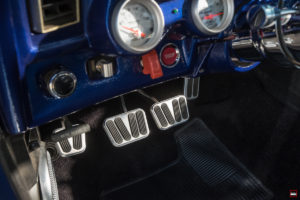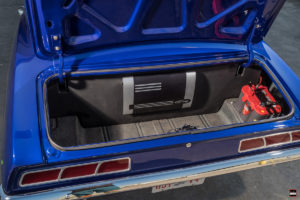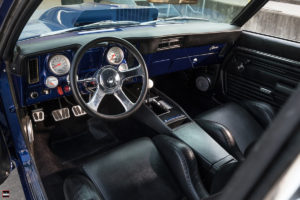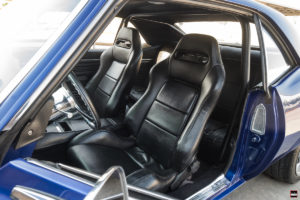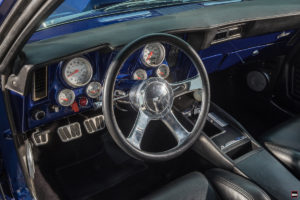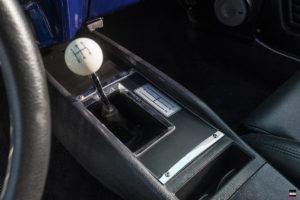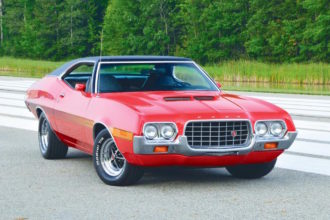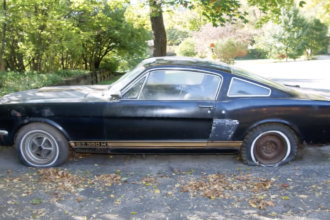photos by: John Jackson
Hiding Under this First-Generation Camaro’s Beautiful Exterior is a Story of an Ever-Evolving Project
The 1969 Camaro is a beautiful machine, it’s a piece of artwork with strokes of rugged and raw appeal. To most people, the first generation Camaro is the epitome of what it means to be a muscle car, then again, others argue that it’s not a muscle car at all, but that’s a moot point. At first glance, this stunning Camaro meets all of the check marks for a great 1st-Gen.
While this ’69 Camaro is certainly a head-turner, it’s not exceptionally threatening looking. What we’re going to tell you about it is pretty unexpected; your author always stops shy of calling a first-gen a ‘sleeper’ in any capacity. When you’re driving a first-gen, it can be in any condition with any given configuration of modifications, and all eyes are still on the car — so sleeper isn’t a great term for this build, it’s something else.
When you really start to give it a good look over, however, that’s when the alarm bells go off that there’s something a little more than looks that’s attention grabbing about this Camaro. For one, the exhaust gives some hints that something sinister is lurking under the hood. It’s large and visible from the outside side profile of the car, the headers also come off the engine with a pretty noticeable tilt. That hood also seems to have quite an extra bit of clearance, large air intake, perhaps? Hardly.
“I like the fact that I can get in and drive is anywhere, and beat up on late model cars.” -Glen Bethke
While this Camaro, painted Ford Sonic Blue, is certainly show quality and looks like a perfect restoration, it’s more, much more. Under that big 6-inch cowl induction hood is indeed something in need of extra clearance! When the Camaro’s owner, Glen Bethke, brought it home in 2013 with a 383 cubic-inch SBC under the hood and 5-speed transmission, he may not have expected it to end up in this form either.
It didn’t take long for the small-block to become boring to Glen. He also didn’t like the way the car handled. So phase one was taking the Camaro to GAP Racing in Houston, Texas to have a 430 horsepower LS3 swapped into the car.
The new engine is a 376 cubic-inch 10.7:1 compression ratio machine with a nodular crankshaft, and Chevy Performance pistons more suitable for the next round of modifications. It also sports a Holley LS retrofit oil pan to make the transition to the new GM engine more painless.
“It didn’t take Glen long to upgrade it with a camshaft and MAST Motorsports heads.” -Tim Palazzolo, Owner of GAP Racing
After the LS3 was installed, Glen wanted more from his new engine, so a heads and cam swap were in-store. The engine was beefed up with a COMP Cams custom-ground 247/251 .623”/.623” with 114 LSA camshaft, and a set of MAST Motorsports LS3 cylinder heads.
While a heads/cam LS3 is a pretty stout setup, it didn’t end there. You see, this car is an evolution. Glen’s horsepower bug was not satisfied by the LS3 swap, and the heads/cam upgrade wasn’t enough to hold him over, either. What came next in the evolution of this 1969 Camaro was a game changer for the setup.
The next phase, which is stage III by our count, is when things really started to get serious! It consisted of a slew of pretty hardcore upgrades, the shining star of the phase being the 2.9-inch diameter Whipple supercharger. The Hot Rod series Whipple system is complimented by a modified March Performance pulley system with 4.0-inch pulley, and runs 6-pounds of boost. It also has a Whipple intercooler.
To follow these go-fast mods were a slew of other upgrades to make the car both handle and best utilize its new high power setup. Detroit Speed subframe connectors were added, as well as a GAP fabricated 4-point roll cage, and a few suspension upgrades. Since big horsepower needs big stopping power, 14-inch Wilwood brakes were added to all four corners, with the use of Aero 6-piston brake calipers up front.
 Forgeline RB3C wheels came next, this is a popular wheel that we keep seeing on restomods lately. Glen went with a slightly staggered combo with 19×9” in the front and 20×11” on the rear. Wrapped around these wheels are Mickey Thompson drag radial rubbers to give the beast the best possible traction at the pavement. It also got Detroit Speed mini tubs in this phase to wrap it up.
Forgeline RB3C wheels came next, this is a popular wheel that we keep seeing on restomods lately. Glen went with a slightly staggered combo with 19×9” in the front and 20×11” on the rear. Wrapped around these wheels are Mickey Thompson drag radial rubbers to give the beast the best possible traction at the pavement. It also got Detroit Speed mini tubs in this phase to wrap it up.
At this point, the car was an animal, a real carnivore! This didn’t stop the team from making changes and tweaks to the setup, big changes were still ahead for this ever evolving first-gen Camaro.
The TKO 500 that survived the long list of modifications was next on the chopping block. When the team decided they needed something stronger, it was pulled and replaced by a Bowler Performance Transmissions Magnum Tremec 6-speed. A tough LS9 clutch has the backing power needed for the extra torque, while retaining that stock clutch smoothness and drivability.
Along the way, it’s also gotten a Magnafuel 48-psi. fuel pressure regulator, DeatschWerks fuel injectors, and Walbro 400 fuel pump to upgrade the fueling system. It was given MSD plug wires, NGK spark plugs and Auto Meter Ultra-Lite gauges. Those big headers you see hanging down are 1-7/8” Hedman long-tubes that feed into a GAP-fabricated, dual stainless 3-inch system that uses Black Widow Venom mufflers. The Optima battery has been relocated to the trunk, and leather racing seats offer more comfort on the track.
“Since the suspension upgrades. the car drives more like a modern car. Before, it was all over the place.” – Glen Bethke
Although the suspension had already been upgraded at some point during Phase III (and we’ve lost track at this point as to which phase they’re on), the team and Glen decided to go a different direction as one of the latest projects on this Camaro. A RideTech overhaul included front upper/lower control arms, front Shockwave shocks/struts, swaybar, and 4-link rear upper/lower control arms. In addition to the RideTech gear, it also has C6 front spindles, and a power DSE steering box — because manual steering would feel pretty awkward at this point.
What it all adds up to is a 648 horsepower and 631 lbs-ft. of torque making show quality Camaro that has the suspension to keep it grounded and under control. Its got the power and the supporting modifications to back it up. This Camaro will have no problem keeping up with (and passing) modern muscle cars.
While the (current) short-term goal with all of this is to run in some GoodGuys autocross events in the future, Glen definitely appreciates the car’s street car qualities. There’s nothing about this car that makes it too rowdy to take out for a casual cruise. While the makeover was pretty extreme, it was done right, so Glen can actually enjoy this car both on and off the track.
Since this build is an evolution, we don’t expect the team to reach a stopping point anytime soon, although we’re not sure how much further they can go and keep it a streetcar. Glen has actually already brought the car back to GAP Racing to get a built short block, a smoothed out firewall, and a few other GAP Racing touches. It’s clear that Glen is nowhere near ready to ‘say when’ on this build.
Elizabeth is hardcore horsepower enthusiast with unmatched intensity for making things faster and louder. She wakes up for power and performance and only sleeps to charge up for the next project that’s heading to the track. From autocross to drag racing, Elizabeth is there with you, so stay tuned for her unique perspective on horsepower news, builds, tech info, and installs — with her, it’ll never be boring!













